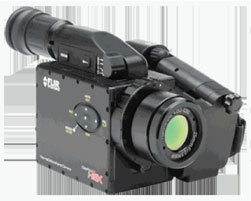VOC Leak Detection
you are here: IRT home > Thermal Imaging > VOC Leak Detection
The Problem?
Fugitive gas emissions cost companies' money and time to locate.
On an annual basis vast sums of hard earned revenue are being invested in the identification and tagging of these leaks as part of companies LDAR (Leak Detection and Repair) programmes.
Fugitive emissions typically account for about 50% of total hydrocarbon (THC) emissions from process plants.
A study by the API found that over 90% of controllable fugitive emissions come from only about 0.13% of the components, and that these leaks are largely random. The majority of the mass emissions come from a small number of components with high leak rates.
- Contact IRT VOC Leak Detection via our online form to arrange a survey or
- Email: vocleak@irtconsult.com
The Solution
IRT Consult, Inc. will deploy Specialist Thermal Imaging Equipment to pinpoint the source of any potential leak that may be present on your site.
Typically we can monitor on average 3,000 + components per hour which offers considerable time and cost savings when compared against the typically 500 components being monitored on a daily basis using traditional "Hand-Held Sniffer" Technology.
Leaks Can Be Detected In:
- Tank cars
- Pipelines
- Process plant
- Compressor Sites
- Refineries
- Chemical Plants
- Power Generation Plants
- Tank Farms
- Gas Transmission Pipelines
- Manufacturing Facilities
- LNG Transport Ships
With surveys being undertaken from the ground and in the case of pipelines we can survey transmission lines from the air in a fraction of the time when compared with traditional methods.
The Equipment
 We use the Flir Systems ThermaCAM GasFindIR HSX thermal imaging camera to identify fugitive VOC Leaks.
We use the Flir Systems ThermaCAM GasFindIR HSX thermal imaging camera to identify fugitive VOC Leaks.
- Lightweight
- Removes the operator from hazardous areas
- Enables detection of leaks in non accessible locations, which would have remained undetected in a conventional sniffing survey
- The leak appears as black smoke in the recorded video clip(s), this allows for accurate identification of leaking components especially where many components may be positioned close together.
Gases Which We Can Detect
This technology is specifically designed for the detection of hydrocarbons and the following is a list of gases which we can currently detect:
- Benzene
- Propylene
- Natural Gas
- Ethanol
- Ethylbenzene
- Heptane
- Hexane
- Isoprene
- Methanol
- MEK
- MIBK
- Octane
- Pentane
- 1-Pentee
- Toluene
- Xylene
- Butane
- Ethane
- Methane
- Propane
- Ethylene
Economies of Scale
- Increased throughput
- 100% accurate with no false positives
- Quick turnaround time
- Compliance - Saves companies from the threat of environmental fines
- Faster than traditional "Sniffer" methods of monitoring for leaks
- Considerable savings to be made on monitoring costs
Environmental Issues
- Reinforces neighbor relations
- Monitoring will enable the reduction of Emissions and emissions fees
- Strengthens the companies Environmental Management programmes
Safety
- Increased Employee and Public Safety
- Repaired leaks can be imaged to provide proof that the detected leak was repaired
- Reduces exposure to toxic substances
- Reduces the risk of explosions
- Images will be captured on video which is ideal for audit trail reporting
Cost £$€
This is an exciting new method of leak detection and each site will be unique so please contact us and we will gladly discuss your project with you in terms of price, duration, availability and applications.


